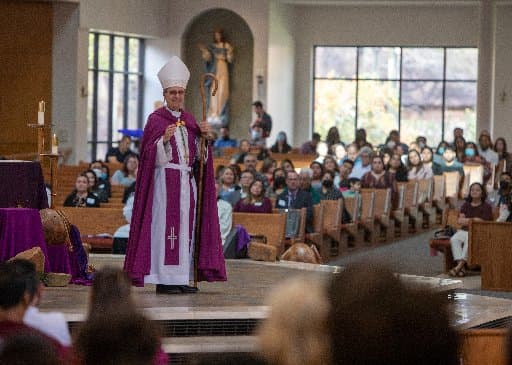PEARLAND, Texas — An important part of the Lent is welcoming those who are in the final phase of their preparation to join or enter full communion with the Catholic Church at Easter.
Catechumens, or the unbaptized, will receive the church’s sacraments of initiation — baptism, confirmation and first Communion at Easter.
Candidates are those who are already baptized and will be received into full communion with the church after they complete their initiation through a profession of faith, followed by receiving the sacraments of confirmation and Eucharist.
For catechumens, Galveston-Houston’s Cardinal Daniel N. DiNardo of Galveston-Houston and Auxiliary Bishop Italo Dell’Oro celebrated the Rite of Election in bilingual ceremonies in four different parishes around the archdiocese: St. Ignatius of Loyola Church in Spring, Christ the Redeemer Catholic Church in northwest Houston, St. Helen Catholic Church in Pearland and the Co-Cathedral of the Sacred Heart in Houston.
People from parishes all around the archdiocese, from Galveston to Spring, attended, including a number from the University of St. Thomas in Houston.
“From every corner of the archdiocese, we come together. It is good that you are here,” DiNardo said, eagerly greeting the congregation at St. Helen. “This is God’s election of catechumens and candidates, those who have been praying and studying the faith. Today the church chooses them, as Christ has chosen you, to move towards the Easter Sacraments.”
During the Rite of Election, catechumens are presented with their godparents to the bishops and to the faith community.
After the catechumens publicly affirmed their intention to join the church, the bishops, on behalf of the church, accept or “elect” them as being ready to take part in the sacraments of initiation.
The ceremony was repeated in dioceses large and small on the first Sunday of Lent.
During Easter Vigil Masses April 16, at least 1,652 people from parishes across the Galveston-Houston Archdiocese are set to become Catholics. An estimated 245 are youth candidates or catechumens.
“The Rite of Election is an important moment in the catechumens’ journey to celebrate the sacraments in the Easter season. Here they will stand and publicly express their desire to be joined to the church through baptism, confirmation and the Eucharist,” said Chris Labadie, director of the Galveston-Houston archdiocesan Office of Worship.
“Just as important, this is when the church, through the bishop, formally acknowledges the conversion and preparation that has already happened by naming them as chosen by God,” he told the Texas Catholic Herald, the archdiocesan newspaper.
Following the Rite of Election, the catechumens, now known as “the elect,” begin a period of purification and enlightenment, which is the final, intense preparation for the reception of the Sacraments of Initiation during the Easter Vigil.
A unique moment happens at the Rite of Election: Representatives from each parish announce the names of those intending to join the church to the bishop, who then views these names in the Book of the Elect. After the rite, the bishop signs the book as a witness to their faith.
For candidates, the Call to Continuing Conversion marks their final preparation to be received into the church.
In Spring, Texas, at St. Ignatius of Loyola, Dell’Oro beamed as pew after pew stood up, each filled with catechumens or candidates, alongside their godparent or sponsor, with family and loved ones nearby.
A husband and wife from St. Michael the Archangel Catholic Church are traveling the journey as candidates together. The young couple, Mary-Margaret and Corey Howell, also are expecting their first child in March.
“We come from a long line of Irish Catholics, but I was baptized in a Presbyterian church near my childhood home growing up, and my wife was Baptist. But now that we are expecting our own child, we wanted to find a Church home,” Howell said.
So they began the monthslong journey of taking classes for what’s now called the Order of Christian Initiation of Adults, or OCIA, which has several stages marked by study, prayer and rites at Mass.
(Over the past two generations it was known as the Rite of Christian Initiation of Adults, or RCIA, but last November during their fall general assembly, the U.S. bishops voted to change the name.)
“We fell in love with the teachings of the Catholic Church,” Howell told the Texas Catholic Herald, Galveston-Houston’s archdiocesan newspaper.
Lauren Gallegos of St. Pius V Catholic Church also decided to become officially Catholic because she remembered her grandmother was Catholic. Although she had not been baptized, Gallegos helped her younger sister attend Catholic school, which reignited her interest. Now the 30-year-old is ready after attending two years of OCIA.
“I am so excited about being able to receive the body and blood of Christ in the Eucharist. It is so very sacred and moving,” she said.
The director of faith formation in English at St. Pius V, Gina Pasket, said she has seen a difference now that her classes have started meeting in person again rather than via Zoom as the pandemic recedes.
“The catechumens and candidates seem more engaged in person, a lot more comfortable sharing with each other, and they are opening up exploring deeper into the Catholic faith,” Pasket said.
DiNardo expressed his appreciation for the intentional work, often very intense and personal, of the catechists and the elect.
“Thank you for being on your journey and coming to the Lord,” he said. “Welcome to this important part of being members of the church. You’re almost there. We pray for you for the next 40 days.”
– – –
Zuñiga writes for the Texas Catholic Herald, newspaper of the Archdiocese of Galveston-Houston, and Ramos is a staff writer and designer for the newspaper.

















